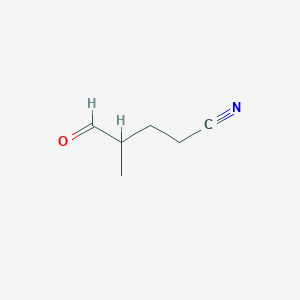
4-Methyl-5-oxopentanenitrile
- Click on QUICK INQUIRY to receive a quote from our team of experts.
- With the quality product at a COMPETITIVE price, you can focus more on your research.
Description
4-Methyl-5-oxopentanenitrile (CAS RN: 3619-38-3) is an organic compound with the molecular formula C₆H₉NO and an average molecular mass of 111.144 g/mol . Its structure features a five-carbon chain containing a ketone group at the fifth position and a nitrile group at the terminal end, with a methyl substituent at the fourth carbon. This compound is used in organic synthesis as an intermediate for pharmaceuticals, agrochemicals, and specialty chemicals due to its reactive nitrile and ketone functionalities .
Comparison with Similar Compounds
Comparison with Structurally Similar Compounds
4,4-Dimethyl-5-oxopentanenitrile
- Molecular Formula: C₇H₁₁NO
- Molecular Weight : 125.17 g/mol
- Structural data (SMILES: CC(C)(CCC#N)C=O) highlight its branched aliphatic chain, which may influence solubility and boiling point .
5-(4-Fluorophenyl)-5-oxopentanoic Acid
- Molecular Formula : C₁₁H₉FO₃
- Molecular Weight : 210.20 g/mol
- Key Differences :
- Applications: Likely used in drug discovery, particularly for nonsteroidal anti-inflammatory agents or enzyme inhibitors.
5-(Methylsulfanyl)pentanenitrile
- Molecular Formula : C₆H₉NS
- Molecular Weight : 127.21 g/mol
- Key Differences: Replacement of the ketone group with a methylsulfanyl (-S-CH₃) moiety.
- Applications : May serve as a precursor for thioether-containing polymers or ligands in catalysis.
Comparative Data Table
| Compound | Molecular Formula | Molecular Weight (g/mol) | Functional Groups | Key Structural Features | Potential Applications |
|---|---|---|---|---|---|
| 4-Methyl-5-oxopentanenitrile | C₆H₉NO | 111.14 | Nitrile, Ketone | Linear chain, methyl branch | Organic synthesis intermediates |
| 4,4-Dimethyl-5-oxopentanenitrile | C₇H₁₁NO | 125.17 | Nitrile, Ketone | Branched chain, two methyl groups | Stabilized intermediates |
| 5-(4-Fluorophenyl)-5-oxopentanoic Acid | C₁₁H₉FO₃ | 210.20 | Carboxylic Acid, Ketone | Fluorophenyl ring | Pharmaceutical agents |
| 5-(Methylsulfanyl)pentanenitrile | C₆H₉NS | 127.21 | Nitrile, Thioether | Sulfur incorporation | Catalysis, polymer chemistry |
Research Findings and Functional Insights
- Reactivity :
- The nitrile group in this compound facilitates nucleophilic additions (e.g., hydrolysis to amides or carboxylic acids), while the ketone enables condensation reactions .
- In contrast, the methylsulfanyl group in 5-(methylsulfanyl)pentanenitrile may participate in thiol-ene click chemistry or act as a leaving group in substitution reactions .
- Physicochemical Properties :
Properties
Molecular Formula |
C6H9NO |
|---|---|
Molecular Weight |
111.14 g/mol |
IUPAC Name |
4-methyl-5-oxopentanenitrile |
InChI |
InChI=1S/C6H9NO/c1-6(5-8)3-2-4-7/h5-6H,2-3H2,1H3 |
InChI Key |
WZGRZLPEJDJMAI-UHFFFAOYSA-N |
Canonical SMILES |
CC(CCC#N)C=O |
Origin of Product |
United States |
Disclaimer and Information on In-Vitro Research Products
Please be aware that all articles and product information presented on BenchChem are intended solely for informational purposes. The products available for purchase on BenchChem are specifically designed for in-vitro studies, which are conducted outside of living organisms. In-vitro studies, derived from the Latin term "in glass," involve experiments performed in controlled laboratory settings using cells or tissues. It is important to note that these products are not categorized as medicines or drugs, and they have not received approval from the FDA for the prevention, treatment, or cure of any medical condition, ailment, or disease. We must emphasize that any form of bodily introduction of these products into humans or animals is strictly prohibited by law. It is essential to adhere to these guidelines to ensure compliance with legal and ethical standards in research and experimentation.















